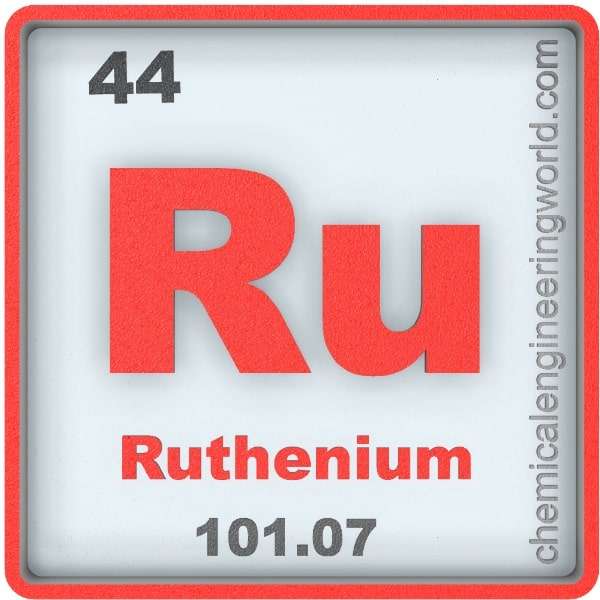Ruthenium Element Properties and Information

Ruthenium Element Properties and Information
Ruthenium is forty-fourth element on the periodic table. Elements are arranged in the periodic table on the basis of the atomic number. Atomic number is the number of protons in the nucleus of the atom. Ruthenium has an atomic number of 44. It is located in the Group 8 and Period 5 of the periodic table of elements. It is denoted by Ru. The name is derived from ‘Ruthenia’ which is Latin name for Russia.
Gottfried Osann investigated some platinum which he received from the Ural mountains. He reported that he found three new elements which he named as; pluranium, polinium, and ruthenium. The first two elements were never verified to exist but the third was verified and confirmed by Karl Karlovich Klaus in 1840. He let the name of the element be ruthenium.
Ruthenium is one of the rarest element found on Earth. It is always found in combined form. Also, it is mostly found to be in ores with platinum element. Common minerals are pentlandite, and pyroxinite.
Physical Properties
- Ruthenium is a silver shiny transition metal.
- The atomic mass of ruthenium is 101.1
- The melting point of ruthenium is 2250°C
- The boiling point of ruthenium is 4150°C
- The density of ruthenium is 12200 in S.I. units at 20°C
- Ruthenium has seven naturally occurring stable isotopes and thirty-four radioactive isotopes.
Chemical Properties
- Ruthenium does not get tarnished upon being exposed to air at ambient condition.
- Ruthenium oxidizes upon heating above 800°C.
- Acids are unable to attack ruthenium. It does not get attacked by aqua regia also.
- Ruthenium is susceptible to attacks by alkalis and halogens at high temperatures.
- Ruthenium is the only 4d transition metal which assumes a group oxidation state of +8.
Methods of Production
Electrorefining & Reduction: Ruthenium is obtained as a by-product from electrorefining of copper, nickel, or platinum ores. During the process ruthenium gets stored in anode mud. Sodium peroxide is fused with the mud and then the mixture is subjected to aqua-regia. This is done to convert the components in mud to metal solutes. Ruthenium does not get dissolved in aqua-regia so it is separated and present in the undissolved residue. The residue is oxidised thus volatile oxides of ruthenium are obtained. Then ammonium chloride is used to precipitate it as ammonium ruthenium chloride. It is reduced using hydrogen. The reduction obtains the metal in powder form or in sponge form.
Relevance in Chemical and Related Industries
- Alloys: Ruthenium enormously increases the corrosion resistant properties, and durability when it is added in small quantities to palladium, platinum, and titanium alloys. They are especially useful in manufacturing thin plate or thin film metal alloys.
- Catalyst: Ruthenium is actively used for catalysis in both types of reactions; homogeneous and heterogeneous reactions. They are primarily used for olefin metathesis, transfer hydrogenation, production of drugs and advanced materials. Fisher-Tropsh synthesis is a popular example where ruthenium is used as a catalyst.
Relevance in Other Industries
Microelectronics: Ruthenium compounds have the potential to completely replace other metals and silicides in microelectronics components. Also, ruthenium oxides are useful for its properties enable it to be compatible with the semiconductor processing techniques needed to manufacture microelectronics components.
Health Effects on Exposure
Toxic: Ruthenium by itself is inert but all ruthenium compounds are highly toxic and some are even carcinogenic. They stain the skin very strongly and also have a strong tendency to get accumulated in bones.
Effects on Surroundings
No negative effects has been observed.
References:
https://en.m.wikipedia.org/wiki/Ruthenium
https://www.lenntech.com/periodic/elements/ru.htm
































